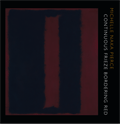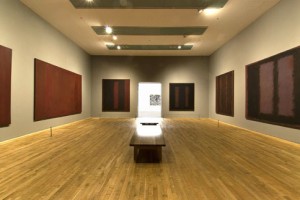
Continuous Frieze Bordering Red by Michelle Naka Pierce | Fordham University Press 2012 | $19.00
Michelle Naka Pierce’s Continuous Frieze Bordering Red is made up of five lines spanning sixty-eight pages. Read the first line of the book all the way through, and then the second line, and so on. Pierce conceived of this project during the study of Mark Rothko’s Seagram murals at the Tate Modern in London. She writes a room with sixty-eight sides. We are surrounded.
Pierce chooses to begin with an epigraph by Rothko, the ending of which leads us not toward the grandiose, but toward the uncomfortably intimate: “However you paint the larger picture, you are in it.”
At first I wanted to see Pierce’s text installed, each page depicting a scene in a sequence of discrete panels. I wanted to see the breadth of such a room—I wanted to be inside of it. Then I realized—I’m in it. Pierce is in it. This sixty-eight-sided room is the spectral polygon we inhabit.
***
The scope of this book and the gestures it allows the reader to make—sweeping the eye across the page, continuing to turn, gathering momentum—resemble the panning motions of a camera lens or an artist laying down a wash of paint. But when Pierce zooms in, studying the expanse, she finds the body situated as a color—she finds memory and breakage in what looks solid. Nothing is as fluid as a pan or wash might lead you to believe: “Racial fluidity, as you / know it, is a myth” (43-44). Continuous and continually shifting up close. Zoom out, and it looks like five lines of text spanning sixty-eight pages.
Continuous Frieze Bordering Red succeeds because it takes a two-dimensional visual catalyst (Rothko’s murals) and concentrates on the spatial quality and physicality of the brushstroke, as well as the ways in which the canvases install themselves in a room. It uses this knowledge as a framework for imagining the entrapped/migratory location of the hybrid/mixed race body as it exists in an ever-increasingly benign/brutal police state and allegedly “post-racial” landscape.
Pierce not only commits to creating an architecture in which to situate this/her/our ever-shifting self, but allows us to enter and participate in the texture of that movement/room by catching us in the process of continually turning the page. In a cluster of text not incorporated into the frieze, Pierce concludes, “Yet the architecture cannot be seen from this angle” (32). She doesn’t offer the larger picture in its entirety, but a sequence of discrete panels—a “freeze”—in which we are caught. Using the second person pronoun, Pierce paints her reader into the scene: “You are this continuous sequence with adjacent elements not perceptibly different. / Assassinate. Little more little. Repeat instruction” (24-25).
While reading this book, I was constantly sort of losing my place, or moving back to catch again the beginning of a spectacular sentence (sequence) and propelling forward into an awesome, continuous frieze/freeze, negotiating across pages and multiple horizons. It was an absolute joy to keep turning the pages, to stay in motion with Pierce, to be always already moving/across.
In the process of reading/moving through this book, we are also tracing back over the places we have been, reaching page 68 and returning then to 1, returning/arriving, repeating a trace. Pierce remembers that “[a] cultural trace is repetition [imitating your mother’s salty palms as they shape / onigiri]” (26-27). At each tracing, the color deepens, achieves density, must be interrogated, as in: “The confines are / invisible but present [i.e., enforceable]. No one will check your visa. Your accent, however, will be / questioned” (50-52).
***

Condensation / takes on new significance, as you unpack not only your things but your national identity, which is / already in a state of flux from an ethnic standpoint. Distance plays tricks on your perception. From afar, / it looks as though the entire canvas wasn’t used, but up close, you see beige paint and hope this isn’t idle / commentary on your life. You hear your text [a taxonomy of cultural products] translated into another / language and find it’s like being introduced to yourself in the mirror, only you don’t recognize that it’s / you. Who is this broker between forms and documents, not evenly in between? This is your plight, / which reminds you that moving from one country to another just after birth doesn’t allow for roots to set / in: they are exposed, as you are, dangling from a terracota pot (3-11).
Pierce strains our focus, placing a line on top of a memory on top of a color, “[a]s if the focal point were always in motion or absent from the conversation” (23). Rothko’s slabs of color offer no “subject” to focus on, no foreground image; as such, Pierce finds the “subject”/herself in/visible in the wash, an object of scrutiny, a body that emerges when stared at. “You arrive within an unfamiliar season and have difficulty embodying the space of ‘I'” (53) and it is this “I” that is either “always in motion or absent.”
The background bleeds/morphs and the foreground blurs. Stories of transportation, train stations, air travel, immigration, customs, access, status, weather, mail, cues, approaching, embarking, departing, arriving, local, locals, location—arise from a single color. In the book’s horizontal orientation, vertical “trips” (reading the line underneath rather than across) offer accidental slippages; “You are living / what some call a polycontinental transexperience. Only no one really calls it that” slips into “You are living / hyphen” (42-43).
The “fucking / hyphen”—a loaded symbol of miscegenation, global intimacies and dislocations—is just one of the marks Pierce contends with as she “convey[s] the floating / border” (51-52) or floating “boarder.” Pierce’s text hyphenates—it breaks both in the crease (of the book) and in the turn (of the page). We read, “A demarcation, where this sentence ends and” turning the page, “this line begins with a reverberation” (29-30). These crossings/hyphens are like painter’s tape under which color seeps to mar the line: “In this unkempt sentence, in this lattice of vagueness, / lies violence” (31-32). Pierce pulls back, color peels. Separation, passing. Not absolutely permanent or perfect, these borders are casually and randomly enforced, fleshy and violent.
You anticipate the worst as you approach customs: / the lines, the interrogation, the sullied plexiglas (2-3).
Boundaries: they exist / on maps. You run into them when you submit your passport. You are annoyed when you are chosen for / a random search […] Checkpoints are real and insistent and at other times rather benign. / Your sense of direction is confused by this (44-49).
How is it that you are able to walk freely / about the cabin while others risk [der]ision at the hands of Metro station announcers? Your skin, / in the end, is a similar shade of foreign. A 45-minute delay due to “a person on the tracks” broadcasts / the conductor. You’d be wrong to think this wasn’t an act of suicide, even though others may call it illegal / immigration (59-63).
***
This morning you wake to precipitation and soon learn that repeating phrases [even / slowly] doesn’t make them any less foreign to your ear. You ask a local to pronounce something / to make sure that the final letter is silent: “yes, we eat the end of our words.” Definitions continue to / confuse in much the same way you resemble an outcast. Integration renovates the hybrid’s wiring / while leaving the facade more or less intact. “You are as white as a non-white girl can get.” Or: “In this / moment, you seem very Asian to me.” (9-14)
Pierce’s choice to use Rothko’s paintings as an entrance into a discussion of immigration and Japanese American hybridity is an interesting collision. In a long-standing tradition of white painters taking inspiration from Asian forms and painting over history, and in the long-standing reality of indigenous folks being surrounded and subsumed by whiteness and becoming invisible, Pierce inserts herself into the frame of Rothko’s colors. That she enacts herself here in Rothko’s paint [“Yearning: salvage and recovery” (54)] shows that such variation does exist, even once the final stroke has dried.
***

I’ll leave you with five lines / borders / swathes / hyphens:
Can / you reclaim ‘mongrel’? Strain the semantic residue off? (54-55)
The border is a scar on the forearm. Is / a conversation with your naturalized mother or white partner. Is the syllable added in the transliteration / of your name (24-26).
You terrorize the unp[red]ictable scene. / There is no place, really, where you are not alien. But you are studying the cadence of passing from side / to side, the grammar of intricate mobility (45-47).
What is the / impact on the itinerant body? A shifting present. An assortment of venues […] And you begin to embrace your incongruent parts, to / sketch a shelter out of fragments (21-25).
Indigenous to neither, you remain ainoko (50).
Now, turn / the / page.
2 thoughts on “Review: Michelle Naka Pierce’s CONTINUOUS FRIEZE BORDERING RED”